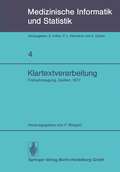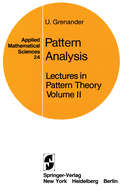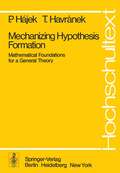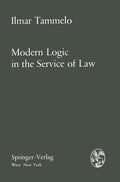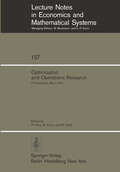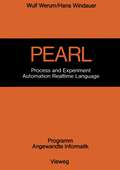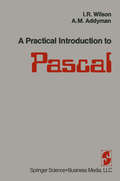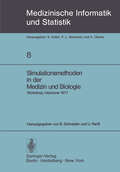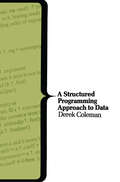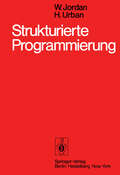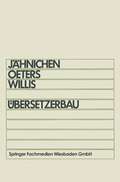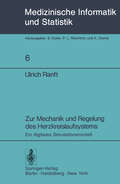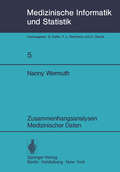- Table View
- List View
Klartextverarbeitung: Frühjahrstagung 1977, Fachbereich Medizinische Informatik der GMDS und Fachausschuß 14 der Gl in Gießen (Medizinische Informatik, Biometrie und Epidemiologie #4)
by F. WingertLectures in Pattern Theory: Volume 2: Pattern Analysis (Applied Mathematical Sciences #24)
by U. GrenanderMany persons have helped the author with comments and corrections, and I would like to mention D. E. McClure, I. Frolow, J. Silverstein, D. Town, and especially W. Freiberger for his helpful suggestions and encouragement. The work in Chapters 6 and 7 has been influenced and stimulated by discussions with other members of the Center for Neural Sciences, especially with L. Cooper and H. Kucera. I would like to thank F. John, J. P. LaSalle, L. Sirovich, and G. Whitham for accepting the manuscript for the series Applied Mathematical Sciences published by Springer-Verlag. This research project has been supported by the Division of Mathematical and Computer Sciences of the National Science Foundation and (the work on language abduction, pattern processors, and patterns in program behavior) by the Information Systems Program of the Office of Naval Research. I greatly appreciate the understanding and positive interest shown by John Pasta, Kent Curtiss, Bruce Barnes, Sally Sedelov vi PREFACE and Bob Agins of the Foundation, and by Marvin Denicoff of the Office of Naval Research. I am indebted to Mrs. E. Fonseca for her untiring and careful preparation of the manuscript, to Miss E. Addison for her skillful help with the many diagrams, and to S.V. Spinacci for the final typing. I gratefully acknowledge permission to reproduce figures, as mentioned in the text, from Cambridge University Press and from Hayden Book Company. Also, to Professor J. Carbury for permission to use his illustration on page 704.
Mechanizing Hypothesis Formation: Mathematical Foundations for a General Theory (Universitext)
by P. Hajek T. HavranekHypothesis formation is known as one of the branches of Artificial Intelligence, The general question of Artificial IntelligencE' ,"Can computers think?" is specified to the question ,"Can computers formulate and justify hypotheses?" Various attempts have been made to answer the latter question positively. The present book is one such attempt. Our aim is not to formalize and mechanize the whole domain of inductive reasoning. Our ultimate question is: Can computers formulate and justify scientific hypotheses? Can they comprehend empirical data and process them rationally, using the apparatus of modern mathematical logic and statistics to try to produce a rational image of the observed empirical world? Theories of hypothesis formation are sometimes called logics of discovery. Plotkin divides a logic of discovery into a logic of induction: studying the notion of justification of a hypothesis, and a logic of suggestion: studying methods of suggesting reasonable hypotheses. We use this division for the organization of the present book: Chapter I is introductory and explains the subject of our logic of discovery. The rest falls into two parts: Part A - a logic of induction, and Part B - a logic of suggestion.
Modern Logic in the Service of Law
by Ilmar TammeloIn face of persistent and notable efforts taking place in many parts of the world today to make modern logic a tool of legal thought, lawyers are inclined to ask: "What is the real significance of modern logic for us?" A sum mary answer to this question is: "Modern logic provides up-to-date principles and methods for tracing and display ing self-consistent thought, which is indispensable for ef ficient and proper performance of legal tasks." This answer may not satisfy the questioner's curiosity about modern logic in the service of law. If he wants to know more, he is invited to join in an investigation of the various ways in which modern logic can prove useful in legal thought. The present book proposes to engage in such an investi gation, and in doing so it also endeavors to meet various challenges to legal logic. If the value of this logic is totally denied, a reaction to this denial is to ask what its reasonable alternative could possibly be. So far there appears to be no sensible reply to this question. The merit of many specific criticisms of legal logic is indisputable.
Nonlinear Dynamics of Elastic Bodies (CISM International Centre for Mechanical Sciences #227)
by Z. WesolowskiOptimization and Operations Research: Proceedings of a Workshop Held at the University of Bonn, October 2–8, 1977 (Lecture Notes in Economics and Mathematical Systems #157)
by R. Henn B. Korte W. OettliOrganisation von Rechenzentren: Workshop der Gesellschaft für Informatik Göttingen, 11./12. Oktober 1977 (Informatik-Fachberichte #15)
by D. WallPattern Recognition: Ideas in Practice
by Bruce G. BatchelorPattern recognition is a child of modern technology; electronics and computers in particular have inspired research and made it possible to develop the subject in a way which would have been impossible otherwise. It is a rapidly growing research field which began to flourish in the 1960s and which is beginning to produce commercial devices. Significant developments have been made, both in the theory and practical engineering of the subject, but there is evidence of a schism developing between these two approaches. Practical machines have usually been designed on an ad hoc basis, with little use being made of advanced theory. It is difficult to provide a rigorous mathematical treatment of many problems pertinent to a practical situation. This is due, in part at least, to a conceptual rift between theory and practice. The mathematics of optimal systems is well developed, whereas pragmatists are more concerned with vaguer ideas of reasonable and sufficient. In some situations, the quest for optimality can constrain research and retard practical progress. This can occur, for example, if too narrow a view is taken of "optimal": the accuracy of a system may be optimal whereas its speed, cost, or physical size may be grossly suboptimal. The objective of this book is to present a glimpse of the pragmatic approach to pattern recognition; there already exist a number of excellent texts describing theoretical developments.
A Practical Introduction to Pascal
by WILSON/ADDYMANThe popularity of Pascal as a teaching language has rapidly increased, as demonstrated by Addyman's survey conducted over a11 European and American institutions (Comput. Bull., Se ries 2,8, June 1976,31). This is due both to the desirable features of the language and to the ease of producing an efficient com piler. As an instance of the latter, the authors have investigated the full CDC CYBER compiler and found it to throughput at 1.8 times the rate of the manu facturer's Fortran compiler. These features of the language and compilers have also been favourably regarded by system programmers and users of rnicroprocessors. In the latter field, it is the belief of the authors that Pascal will supersede the programming language BASIC. Specifically, undergraduates in the Department of Computer Science at Manchester University program largely in Pascal. An introductory le~ture course on basic programming techniques, given at Manchester, has been taken as a basis for this book. In addition to lectures, the course consists of two kinds of practical session. The first is based on the solution of short pencil-and-paper exercises. The second requires the student to write complete programs and run them in an 'edit and go' mode on interactive computer terminals. Each chapter of the book conc1udes with exercises and problems suitable for these purposes. Although solutions to a11 of these are not presented in the book, teaching staff may obtain them by application to the authors.
Programmiersprachen: 5. Fachtagung der GI, Braunschweig, 8./9. März 1978 (Informatik-Fachberichte #12)
by K. AlberProgramming Methodology: A Collection of Articles by Members of IFIP WG2.3 (Monographs in Computer Science)
by David GriesThis volume is being published for two reasons. The first is to present a collection of previously published articles on the subject of programming methodology that have helped define the field and give it direction. It is hoped that the scientist in the field will find the volume useful as a reference, while the scientist in neighboring fields will find it useful in seriously acquainting himself with important ideas in programming methodology. The advanced student can also study it-either in a course or by himself -in order to learn significant material that may not appear in texts for some time. The second reason for this volume is to make public the nature and work on programming methodology of IFIP Working Group 2.3, hereafter called WG2.3. (IFIP stands for International Federation for Information Processing.) WG2.3 is one of many IFIP Working Groups that have been established to provide international forums for discussion of ideas in various areas. Generally, these groups publish proceedings of some of their meetings and occasionally they sponsor a larger conference that persons outside a group can attend. WG2.3 has been something of a maverick in this respect. From the beginning the group has shunned paperwork, reports, meetings, and the like. This has meant less pUblicity for IFIP and WG2.3, but on the other hand it has meant that meetings could be devoted almost wholly to scientific discussions.
Real Time Programming 1977: Proceedings of the IFAC/IFIP Workshop, Eindhoven, Netherlands, 20-22 June 1977
by C. H. SmedemaReal Time Programming 1977 covers the proceedings of the IFAC/IFIP Workshop, held in Eindhoven, Netherlands, on June 20-22, 1977. The book focuses on the languages, methods, and techniques in real time programming, including debugging systems, hardware, parallel programs, and multi-processor systems. The selection first discusses experience with the programming language modula; flexible approaches to process communication; and high level process control “Esprit“ and its source level debugging system “Solda“. The book then takes a look at software tools for designing and realizing distributed systems in process control and steps in implementing a parallel code executor, including system decomposition, challenge of the new hardware, and situation of real-time programming. The publication reviews software specification language for sequential processes and petri nets for proving correctness of parallel programs. Concerns include state graphs as a model for automata and petri net application to programs. The text also focuses on real-time distributed processing system using GEC 4000 series computers; integration of high-level interpretive software with microprocessor-based distributed control systems; and software approach for multi-processor systems. The selection is a vital reference for readers interested in real-time programming.
